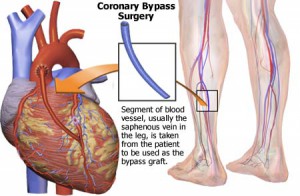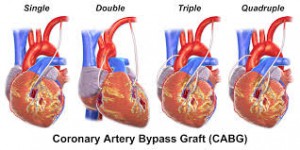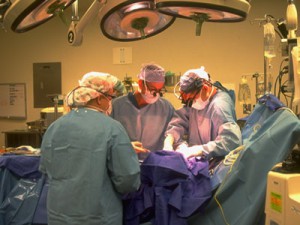Coronary artery bypass surgery is done to provide “detours” around the partially or completely blocked arteries. With a new open “bypass system” the heart can now receive its much needed blood supply.
Coronary artery bypass surgery is performed to provide relief of angina, to improve the pumping ability of the heart muscle, to prevent heart attacks, and to reduce the use of heart medications, all of which should improve a patient’s quality of life. The indications for surgery vary, depending on each patient’s symptoms and findings at the time of heart catheterization. Your surgeon and cardiologist will discuss the reasons for recommending surgery to you.

The saphenous vein is commonly used for grafts. These veins are used by the surgeon as an alternate vessel to deliver blood to the heart muscle below the point of the blockage. The surgery reroutes the blood flow to supply areas of the heart muscle not receiving enough blood.
Traditional Bypass Surgery
Coronary artery bypass surgery became routine in the late 1950s with the invention of the heart-lung machine. With “traditional” bypass surgery, surgeons use the assistance of the heart-lung machine along with medications to stop the heart so the bypass can be performed on a motionless field. The heart-lung machine is referred to as a “pump” because it continues to mechanically pump oxygen and nutrients to the body during surgery.
Beating Heart Bypass Surgery

One of the greatest benefits of this approach is that the surgeons can perform multiple bypass grafts on all areas of the heart, including the backside (posterior), at the same time. What this means is, the surgeon can perform a triple (three bypass grafts), quadruple (four bypass grafts) or more through a middle of the chest incision all off-pump.
Benefits
- Decreased length of hospital stay.
- Less trauma due to the elimination of the heart-lung machine
- Reduction in need for blood transfusions
- Fewer cognitive and neurological consequences, such as stroke
Centre of Excellence for Cardiac Surgery in India
-
Our state of the art hospitals in India have a 99.5 % success rate of performing most complex cardiac surgeries at the most affordable cost compared to similar modern facilities anywhere in the world.
- Highly Experienced and skilled US/UK Board certified team of heart surgeons and cardiologists work together to provide comprehensive, multidisciplinary care to patients suffering from heart diseases
- State of the art infrastructure, cutting edge technology providing care to patients Our doctors, nurses, technicians and heart experts bring the promise of unparalleled excellence in patient care
- Most Advanced Operation Theatres / Robotic surgery suite – State of the art equipment and monitoring devices necessary to successfully perform complex heart bypass, percutaneous valve surgeries, complex hybrid aortic aneurysm interventions and minimally invasive cardiac operation.
To know more about Bypass Surgery in India please visit this link : https://safemedtrip.com/medical-services/heart-surgery-in-india/cardiac-bypass-surgery-and-heart-valve-replacement-surgery-in-india.html

 Click to WhatsApp
Click to WhatsApp +91-9899993637
+91-9899993637

 Our state of the art hospitals in India have a 99.5 % success rate of performing most complex cardiac surgeries at the most affordable cost compared to similar modern facilities anywhere in the world.
Our state of the art hospitals in India have a 99.5 % success rate of performing most complex cardiac surgeries at the most affordable cost compared to similar modern facilities anywhere in the world.


